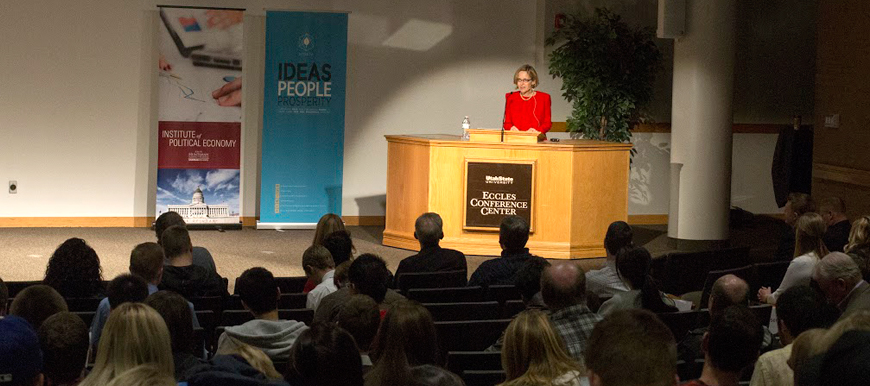Bestselling author speaks on past president
Amity Shlaes, a New York Times best-seller, journalist and teacher, spoke to students and community members about previous United States President Calvin Coolidge on Wednesday in the Eccles Conference Center.
The event, hosted by numerous Utah State University departments, was Shlaes’ second appearance at USU. Students from all areas of study, including political science, economics and communications attended the event for classes or were encouraged by professors.
Shlaes published the book “Coolidge” in 2013 about the man of strong faith, who she refers to as “my forgotten president” and “the hero you never knew you had.”
Shlaes described the time period leading up to the Warren Harding-Coolidge team being elected as president and vice president in 1920. They were known for their strong stance on opposing overspending by the government, Shlaes said, which was unusual because of the common mindset that administrations always said yes. Their plan was to reduce taxes and the federal budget.
Beginning in 1922, Harding grew tired of keeping up appearances and took a break from so many tax cuts, Shlaes said. He didn’t like saying, “No,” so much, and though the country was fairly prosperous, a number of Harding’s implemented plans were falling through.
Harding died in August 1923.
“He died, I think, of his sorrows, of his recognition of a job that didn’t get finished,” Shlaes said.
Coolidge was sworn into office that same month by his father while on vacation in his hometown Plymouth Notch, Vermont. Throughout his presidency, he was called many things, one of which was “the accident of an accident,” a stab at both Harding and Coolidge, for not always being taken seriously.
“Where Harding was divided as the new president, (Coolidge) was all one,” Shlaes said. “He was from Vermont. There’s not much money there. … He was a saver. If he took one of those tests you take to figure out what career you should have, he would fall into an actuary, an accountant, an attorney. His entire being wanted to budget. That’s just the way he was built.”
Coolidge was known to say, “I am for economy, and after that I am for more economy,” his definition of economy being interpreted by Shlaes as saving.
He vowed to finish what he and Harding had started and would do it “to perfection,” in his own words, Shlaes said. Reducing taxes in the United States became his administration’s Desert Storm, their Civil War. It was what they battled for while he was in office, she said.
After being in office 67 months, from August 1923 to March 1929, Coolidge’s impact left the federal budget lower than it had been when he first came into office, Shlaes said.
“Ronald Reagan is very famous for his tax cuts, and he got the top tax rate down to a famous level, the ‘Reagan level,’ which was 28 percent,” Shlaes said. “Well, what do you think Coolidge’s top rate was? Twenty-five percent. It’s blasphemy to say, but I’ll say better than Reagan.”
Amy Lanham, a junior majoring in accounting, came to the event because her economics professor suggested they go to learn more about economy from a different point of view.
“It was really interesting. I’ve never heard anything like it,” Lanham said. “It’s really important to consider economics when looking at politicians.”
It was also interesting due to the fact that not many people talk a lot about Coolidge, Lanham said.
Kurt Lundgren, a senior majoring in marketing, came because he could receive extra credit in his economics class.
“I thought it was very informative about the the whole pre-Depression era, really,” Lundgren said.
To learn more about Shlaes visit her website at www.amityshlaes.com.
— mandy.m.morgan@aggiemail.usu.edu

